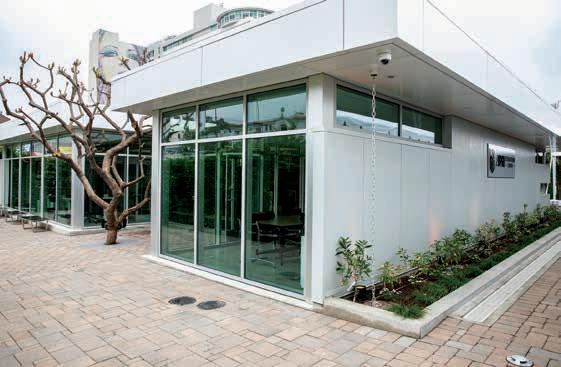
22 minute read
In the News
The new ASC ARRI Educational Center.
American Society of Cinematographers Opens New ARRI Educational Center
In late September, the American Society of Cinematographers completed construction of its new ASC ARRI Educational Center. Located behind the historic ASC Clubhouse in Hollywood, the building now serves as a hub for the organization’s ongoing efforts to educate the next generation of filmmakers on the art and craft of cinematography. The new 5,000-square-foot space consists of offices, a large meeting room, and is made possible through the support of ARRI. The centre also houses an archive of historic American Cinematographer magazines. The official opening of the new structure coincides with the ASC’s celebration of its 100th anniversary with members and sponsors. (More to come in the December issue).
Raj Jawanda Joins Whites as National Director, Rental Maintenance
William F. White recently announced that Raj Jawanda has been appointed to the full-time position of national
Credit: Courtesy of the ASC
director, rental maintenance. Reporting directly to Garin Josey, executive vice president/chief operating officer, Jawanda will nationally oversee all rental, electrical and maintenance departments, while coordinating with regional general managers on overall operations and department priorities. Jawanda brings more than 20 years of directly related experience to this role. Prior to joining William F. White, he led a project engineering team as technical services manager at APEX Aluminum Extrusions and performed product electrical safety certifications at QAI Laboratories (Quality Assurance Institute).
Minister Rodriguez Announces New Funding Through Creative Export Canada Program
In early September, Minister of Canadian Heritage and Multiculturalism Pablo Rodriguez announced new Creative Export Canada funding for 22 different organizations. The projects, which include those that have received funding under both the first and second intake rounds, will share a total of $8.3 million in funding. This funding will support these organizations in exporting their artistic projects to international markets and help generate significant economic benefits at home by creating jobs and fostering social prosperity. Creative Export Canada is for Canadian organizations ready to export a project that showcases creative content. Its mission is to make Canada’s creative industries more profitable.
DGC Launches Recruitment Drive for Documentary Filmmakers
The Directors Guild of Canada in early September launched a recruitment campaign to bolster its membership among documentary filmmakers. The campaign includes sponsorships at film festivals across the country this fall. Canadian documentary filmmakers have enjoyed global success, but their communities have long been unrepresented or underrepresented in industry circles. This campaign will recruit documentary filmmakers, highlight the commercial and artistic value of their work and give them a stronger voice in policy making. As part of this initiative, the DGC will be waiving its initiation fee and offering 50 per cent off annual dues through 2020. This totals up to $3,500 in savings. DGC members will also gain access to the DGC Benefits health plan, preferred rates on production insurance, as well as the guild’s low management fee group RRSP.
CBS Launches TorontoArea Production Studio
U.S. network CBS in late September officially opened its planned production hub in the Greater Toronto Area. CBS Stages Canada, the 260,000-square-foot Mississauga facility, includes six sound stages, production offices, support facilities and other services for film and television projects. The network, which announced the facility last year, estimates that the hub will generate around $200 million in yearly production expenditures and an average of 300 jobs daily when all six sound stages are filled.
Martini Film Studios Plans Canada’s Largest Complex with 600,000-SquareFoot Expansion
In early September, Martini Film Studios announced a new studio development in Langley, B.C. The studio complex, which will be Canada’s largest, according to Global Construction Review, will triple the production capacity of Martini Film Studios and increase film stock in the region by up to 15 per cent. The 250,000-square-foot facility launched two years ago and plans to add 600,000 square feet of purpose-built sound stages, offices and production support buildings over more than 25 acres, with half the space dedicated to sound stages. Martini’s current projects include Chilling Adventures of Sabrina, Another Life and Snowpiercer.
The AFC Welcomes New Leadership
The AFC, the lifeline for Canada’s entertainment industry, in late September announced the election of Board Member Deborah Bernstein as President of the Board, Board Member Adrian MacDonald as Vice-President, and the appointment of new members Ryan Goldhar, Alan Goluboff, and Hari Krishnan. Gerard Roxburgh will remain a member of The AFC Board as Past President, and Barbara Gordon joins the Executive Committee as Secretary.
From Our Sponsors
William F. White Unveils MovieQuiet Eco Series
William F. White recently introduced the MovieQuiet ECO series, a product line designed to provide clean, reliable, quiet and renewable power to set. The series are available in two models; the 6kWhr and the 26kWhr. Both come outfitted with hospital-grade receptacles, a hospital-grade twist lock, four USB charge ports and charging input connector. The 26kWhr also includes a Joy Connector output and can be utilized in conjunction with multiple trailer options available upon request.
RED Adds HELIUM and GEMINI Sensor Options to RANGER
RED announced recently that its HELIUM 8K S35 and GEMINI 5K S35 sensors will be incorporated into the RED RANGER camera ecosystem. The RANGER HELIUM 8K S35 and RANGER GEMINI 5K S35 are available now via RED’s global network of resellers, participat

ing rental houses, and directly through RED. All three sensor variants of the RED RANGER camera system include the same benefits of the compact, standardized camera body, weighing around 7.5 pounds. The Courtesy of RED RED RANGER camera system consists of three SDI outputs (two mirrored and one independent) allowing two different looks to be output simultaneously; wide-input voltage (11.5V to 32V); 24V and 12V power outs (two of each); one 12V P-Tap; integrated 5-pin XLR stereo audio input (line/mic/+48V selectable); as well as genlock, timecode, USB, and control. Both V-Lock and Gold Mount battery options are supported. The RANGER can simultaneously record REDCODE RAW plus Apple ProRes or AVID DNxHD or DNxHR at up to 300 MB/s write speeds. It also features RED’s end-to-end colour management and post workflow with the enhanced image processing pipeline (IPP2). More information is available at red.com/red-ranger or at your local RED Authorized Dealer.

ARRI Introduces Ultra-Bright LED Orbiter
ARRI in September introduced Orbiter, a new ultrabright, tunable and directional LED fixture.Orbiter’s new six-colour light engine delivers a wide-colour gamut and colour rendition across all colour temperatures, along with smooth dimming from 100 to 0%. With its changeable optics, Orbiter can transform into many different types of lamp heads, including projection, open face, and soft light. Additional features include a fast processor, ample memory, expanded connectivity, a built-in array of sensors, and weatherproof housing. More information is available at: arri.com/orbiter.

Courtesy of ARRI
ACCEPTANCES / AWARDS / NOMINATIONS
David Bercovici-Artieda, associate member (producer/ director and co-editor) BOULEVARD (short), winner: Gold Remi, 2019 Houston World Film Festival; Official Selection: 2019 Miami Independent Film Festival; 2019 New York Shorts Independent Film Festival; 2019 HOLLYSHORTS Film Festival; 2019 Vancouver Latin American Film Festival
Michael Jari Davidson, associate member
(cinematographer) Into Water (short), accepted: imagineNATIVE Originals, 20th annual imagineNATIVE Film + Media Arts Festival, Toronto, October 22-27, 2019 Karim Hussain csc (director of photography) Please Speak Continuously and Describe Your Experiences as They Come to You (short), accepted: Cannes Film Festival - Critic’s Week (May 2019); New York Film Festival (October 2019); London Frightfest (September 2019); Random Acts of Violence (feature), accepted: Fantastic Fest - Austin, TX USA (Sept 2019)
Morgana McKenzie, associate member
(cinematographer and director) Wild (short film), winner: Best Cinematography, Toronto New Wave, Toronto, August 2019
Credit: Luis Pinto
DP Ahmad Al Morsy csc on set in Sofia, Bulgaria, filming his latest feature film Younes, starring Ahmed Ezz also pictured with him.
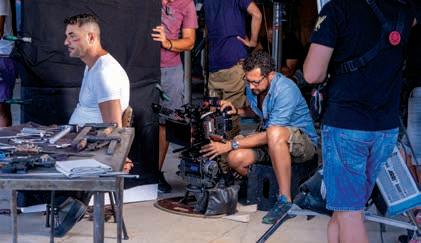
Credit: Luka Cyprian Credit: Mark Hanna
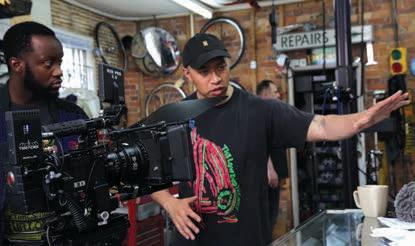
Associate member Othello Ubalde (right) on the set of Coffee Bikes with actor Andy Mill.
From left to right: 2nd AC Coenraad Been; dolly grip Michael Heaton; key grip Graham Harrington; gaffer John Heinekey; 1st AC Agatha Lee; DP Chris M. Oben (associate member); director Raul Inglis; and lead actor C. Thomas Howell during the production of Crimson Point in Vancouver.

Credit: Craig Minielly

Producer/director and co-editor David Bercovici-Artieda (associate member) with actor Carmen Aguirre (right) and script supervisor Kelly McLaughlin (left) on the set of the short film Boulevard.
Cinetx Kinefinity Demo September 18, 2019 Habibi Film Rentals, Toronto
Habibi Film Rentals and Cinetx hosted a drop-in hands-on demo for the new Kinefinity MAVO LF large format Cinema Camera. Attendees had the opportunity to discuss the camera with people who have used it in the field and with a rep from Cinetx, the Canadian supplier for Kinefinity products.
From left to right: cinematographer Adam Gaudreault, cinematographer Giulio Cosmo Calisse, Barry Lank csc and cinematographer Zefred Ansaldo.

Barry Lank csc, cinematographer Giulio Cosmo Calisse and Alex Fensham (HABIBI Film Rentals shop manager).

Karim Hussain csc

Credit: Ken Woroner
What films or other works of art have made the biggest impression on you?
Easily the world of Italian horror movies has been a great inspiration and influence. Great Dario Argento movies like Suspiria, Opera, Tenebrae; the works of Mario Bava, such as Hatchet for the Honeymoon, Blood and Black Lace, Lisa and the Devil; all the great giallo movies and works of Lucio Fulci. I’m also greatly influenced by the work of Alejandro Jodorowsky in all disciplines but primarily his films The Holy Mountain and Santa Sangre; the great ‘70s and ‘80s horror and exploitation films, like the original Texas Chainsaw Massacre, George Romero’s work, and also extreme and bold world cinema.
How did you get started in the business?
I started by making underground horror and experimental movies, first on Super 8 film, then graduating to 16 mm. I never went to film school; I never even graduated high school. I got kicked out because I was making movies that the high school faculty were offended by, even if they were simply underground experimental movies, so I had to learn everything on my own. Basically I read a lot and then picked up a camera and learned from my mistakes. I met a great friend called Mitch Davis in Montreal at a genre film festival in the early ‘90s, and we embarked on my first 16 mm feature called Subconscious Cruelty when I was 19. It ultimately did very well in Japan and caused some noise on the genre film festival circuit, so that got me started.
Who have been your mentors or teachers?
I learned by reading – certainly American Cinematographer was one of my multiple bibles. That and Fangoria magazine. I studied camera manuals meticulously and The Professional Cameraman’s Handbook. So my teachers were books and magazines and learning from failure. Of course, I’ve worked with many directors and producers who’ve helped me greatly along the way and to whom I am eternally grateful, but they are too many to mention and they know who they are.
What cinematographers inspire you?
Mario Bava, one of the great Italian directors, started out as a cinematographer; his camera and lighting ideas inspire me to this day. I love Jack Cardiff ’s [BSC] early Technicolor films; Luciano Tovoli’s [ASC, AIC] work on Suspiria and Tenebrae; Ronnie Taylor’s [BSC] work on Opera. I’m a huge fan of Zbigniew Rybczynski’s amazing innovations on an Austrian movie from the ‘80s called Angst. Andrzej Jaroszewicz did some stunning work for the great Andrzej Zulawski, both as a DP and operator, my favourite being some of the most jaw-dropping science fiction set pieces ever made in On the Silver Globe.
Name some of your professional highlights.
Probably going to the Sundance Film Festival with Jason Eisener’s Hobo with a Shotgun, then the year after that going to the Cannes Film Festival with Brandon Cronenberg’s Antiviral. I would have to say the recent shoot on Brandon Cronenberg’s upcoming Possessor, after four long years of start-and-stop development hell, was also an amazing highlight for me – the culmination of everything I’ve learned as a cinematographer, many new experiments, and one of the best scripts I have been gifted to work with.
What is one of your most memorable moments on set?
On Hobo with a Shotgun, Rutger Hauer taught us many important lessons in terms of trick shooting certain stunts and action sequences that he learned from the best stunt coordinators and specialty camera people around the world. I’ll remember that wisdom and knowledge until the day I die.
What do you like best about what you do?
Honestly, everything. It is the best thing a person like me can ever possibly do, and even when it’s difficult it’s still exactly where I want to be.
What do you like least about what you do?
Nothing. Every day on a movie set is a lucky day. Even the problems are good problems to have, and a privilege.
What do you think has been the greatest invention (related to your craft)?
Probably the Steadicam. In terms of lighting, LED and all the amazing doors it opened, easily.
How can others follow your work?
My website is karimhussaindp.com
The Society congratulates the following members on receiving full CSC accreditation
Ahmad Al Morsy csc
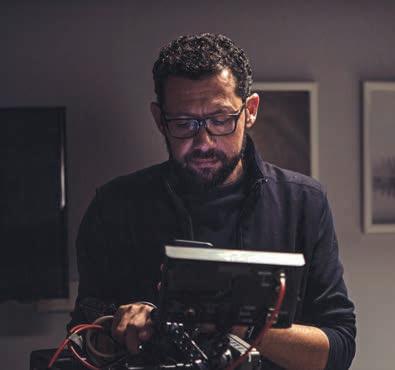
Credit: Khaled Zohny
FILM STUDENTS

Are you graduating from a film or cinematography course and love the idea of becoming a professional cinematographer? JOIN OUR MENTOR PROGRAM
Michael LeBlanc csc

Credit: Ramona Diaconescu
Join the Canadian Society of Cinematographers as a STUDENT MEMBER
And we will enrol you in our MENTOR PROGRAM. Check us out on at www.csc.ca or call the office at 416-266-0591 for more information
Killer Doll Brendan Uegama csc retools
By Trevor Hogg, Special to Canadian Cinematographer

Photo credits: Courtesy of Orion Pictures
fter two direct-to-video releases, the Child’s Play
Afranchise returns to the big screen with a self-titled installment directed by Lars Klevberg (Polaroid) and lensed by Brendan Uegama csc (Riverdale). “I’d seen the original Child’s Play when I was a kid a few times but not in many years,” Uegama states. “I watched it once during prep just as a refresher. I have so much respect for the original film. They did so well with Chucky and created one of the most iconic horror characters of all time. But we are rebooting the film, meaning we are doing a new take on it. It’s a killer doll, yes, but as the script suggests, it’s a different type of doll completely. In the original 1988 film, it’s a human murderer trapped in a doll by voodoo. In our reboot, it’s AI gone bad. “By the time I was asked to do the film, the director Lars and I had already been talking for a month,” the DP explains. “During that process, he would ask me to send him images and artwork I liked so we could get on the same page artistically. I sent him a couple versions of a look book during that time. We would spend time every day tossing ideas back and forth about ways to approach scenes or moments in the script, and if it stuck, it did so because it was the right decision for the film. We plastered our office walls with images and creative collages that we could use as inspiration. Nothing to ever copy, but just to keep creative conversations going. During our endless amount of conversations, we would talk about other movies that held similar feelings we were after for some scenes, moments or story points. That was helpful for us to narrow in. But our visual language sort of just developed throughout the process.”
Chucky (voiced by Mark Hamill) and Andy Barclay (played by Gabriel Bateman).


A good portion of the film was storyboarded. “When I came on, there were already some boards done for a few scenes which was a great start,” Uegama remarks. “Generally, we would try and spend time each day locked in one of our offices and board a scene or two. We had a really good storyboard artist who would take our stick figure boards and draw them into proper storyboards. In addition, there were animatics done for most of our boarded scenes and specifically our big action or kill scenes. This was helpful for everyone in prep to better understand the direction we were going.” What made Child’s Play stand out from other projects that the native of Vancouver has worked on was Chucky. “He wasn’t a CGI character but an animatronic doll that was operated by a group of puppeteers. Working with a doll of that technology was really great.” Multiple Chucky dolls were used on set. “Our main doll was a full animatronic Chucky that was robotic in head movement, facial expressions and arms,” Uegama says. “We used him for 90 per cent of the filming. We also had a Posable Chucky that was photographable and could use it if there was no movement out of Chucky. We used him a few times but not often. Then we had a Stunt Chucky that could be tossed around a bit more and wouldn’t break if it fell. We used him as little as possible, but he came in handy a couple times. When it comes to artistic choice of how we framed him, we kept it fairly normal in the sense that he didn’t have a special lens or a specific degree of tilt to see him at; that was all selective to each shot and what felt right for the story.” Not everything could be achieved without digital augmentation, though. “We all knew from the start that we would use our practical doll as much as possible,” Uegama notes. “No one wanted to make a CG character film. We wanted to make a movie with a puppet. When you see Chucky in the final film, it’s almost always our animatronic doll. Even when his mouth

is moving and he is making facial expressions, that’s us. Sometimes there were face enhancements but more specifically near the end of the film and by design. Early in prep, we knew that we would need to rely on CGI Chucky for shots where he is seen walking from head to toe. We didn’t really do greenscreen work so shooting the visual effects were not too extensive.” Principal photography took place in Vancouver and lasted from September to November 2018. “I was originally brought in for prep at seven weeks out from photography; however, during prep we pushed one week, which gave us eight in total,”
Director Lars Klevberg and Cinematographer Brendan Uegama csc on the set of Child's Play.
Expand Your Horizons
Scalable to meet your vision, the modular new Canon EOS C500 Mark II cine camera comes with an impressive set of pro features – including a 5.9K full-frame CMOS sensor capable of over 15 stops of dynamic range and a newly developed DIGIC DV 7 Image Processor – but equally
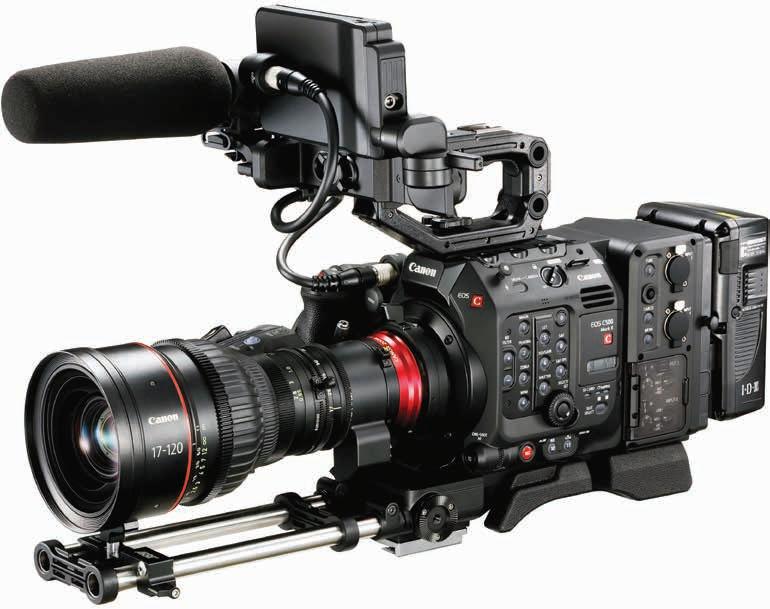
impressive is how readily you can adapt certain functions to meet specifi c shooting needs.
With its optional interchangeable lens mount kits, you can seamlessly swap from EF to Locking EF-C or legacy PL mounts, giving you additional freedom to choose from a broad spectrum of lenses perfectly suited to any given project.
You can also optimize the EOS C500 Mark II using available expansion modules that can be easily attached to the body for various levels of custom functionality, including an add-on 1.7-milliondot OLED EVF in lieu of the integrated LCD touch panel.
Load it up or pare it down: there are many ways to make this camera yours – and make it work for you.
COMMERCIAL SOLUTIONS GROUPCOMMERCIAL SOLUTIONS GROUP
Direct: 416- 644-8010 • Fax: 416-644-8031 • Toll-Free Direct: 1-866-661-5257 • Direct: 416- 644-8010 • Fax: 416-644-8031 • Toll-Free Direct: 1-866-661-5257 • CommercialVideo@vistek.caCommercialVideo@vistek.ca
Uegama recalls. “We ended up with 34 days of photography, which was tight for a film like this. A couple months after we wrapped principal photography, we did return for a few days of additional photography. We built the interior apartment sets and the main hallway on a sound stage and shot there for three weeks. The exterior of Karen Barclay’s [Aubrey Plaza] and Andy Barclay’s [Gabriel Bateman] apartment building and the entrance was in a practical location in downtown Vancouver.” Keslow Camera supplied ARRI ALEXA Mini cameras with Leica Summilux-C lenses and Angénieux zooms. “They are a fantastic company to work with and I have been working with them for a while,” Uegama remarks. “It was a two-camera shoot; however, we would use one camera more often than not unless it was an action scene or we needed two for performances. We did our opening of the film, the Kaslan commercial, on RED cameras. It wasn’t the type of film that used mostly one or two lenses as a rule. I’m sure I used all lenses in the set, but the 40 mm was used quite often. I find the Summilux-C 40 mm to be such a beautiful lens. A great quality to it and so pleasing as a medium close lens.” Lighting equipment was provided by William F. White in Vancouver. “I used a variety of LED and traditional tungsten and HMI. We built our stage with HMI pushing through the windows. We would use tungsten and LED lights up close. Mostly LiteMats for LEDs but some others as well. Our Translight was lit with fluorescent ladder lights that were alternating 5600k and 3200k,” Uegama says. “Whenever I shoot, colour contrast is always important to me,” he notes. “I like to mix colours and find ways to motivate them through story and set design. I worked with our production designer to add specific lighting in certain locations. For example, the art department ended up buying approximately 20 sodium vapour lights of various wattages that I could place around exterior sets to look at during night scenes. In the big massacre in the Zed Mart when the lights go out, I knew we needed something to motivate the lighting. Otherwise, it would just feel so wrong if it was just fake ‘ambient’ light. We added around 15 of those sodium lights outside the store’s windows and pushed them inward as if they were security type of lighting. This gave us a rich warm look and motivated our lighting approach. It also helped us immensely in moving throughout our day. “In the same location, we also added the large TV wall at the end of the store,” he continues. “I was originally looking at one big display idea, then throughout conversations in prep we settled on the nine televisions that you see in the final film. This became a light source for us when we were in that side of the room, but most importantly, it allowed us to have our actors silhouetted by it so we could easily see them at a distance. This was important and made it feel more natural. This was the overall approach to everything. Finding ways to motivate the lighting in the shot, but not always being restricted by that motivation.” According to Uegama, the shooting schedule for Child’s
Top: Brendan Uegama csc on set. Middle: Aubrey Plaza and Gabriel Bateman.
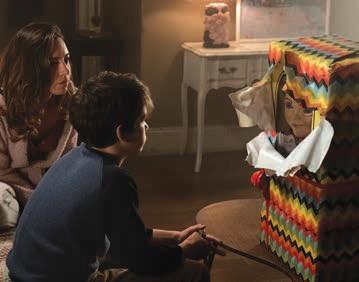


Play worked out perfectly so that a number of shows in Vancouver were ending as production was starting on the feature, so they were able to secure a solid crew. “My gaffer was David Warner and key grip was Dean Reca; they were both strong at leading their team and thinking creatively outside the box. I had David Crone on A camera and Steadicam, and I operated B camera unless it was a really big day when I’d bring in a B operator. Our first camera assistants were Tyler Woeste on A camera, Josh Kjorven on B camera; 2nd camera assistants were Amie Gibbins and Laura Hyvarinen, and DIT was Dwight Hartnett. It was a top-notch camera department and they all worked so hard at helping make this show happen. Our production designer Dan Hermansen [Supernatural] did a fantastic job with his team.” The DI was done at Encore in Vancouver under the supervision of colourist Claudio Sepulveda (The Order). “Claudio is fantastic,” Uegama remarks. “We did the initial pass in just under two weeks. Then I did one more day, and there were a few extra days, as visual effects shots would come in to match. It was very fast for this type of film, and we could have used an extra week or more in there. Luckily, Claudio was so quick and good that we were able to accomplish a lot in the time we had.” There was no shortage of challenges throughout the production, Uegama reveals. “Whether it was the tight schedule, working with child actors, time constraints, an animatronic doll or just general problemsolving, it was just like anything else,” he says. “You know your goal and plan, and you move forward towards it without allowing the challenges to dictate the quality of the film.”
Top: Klevberg and Uegama on set.Middle: Klevberg and Uegama discuss a shot. Bottom: Andy going after Chucky.






